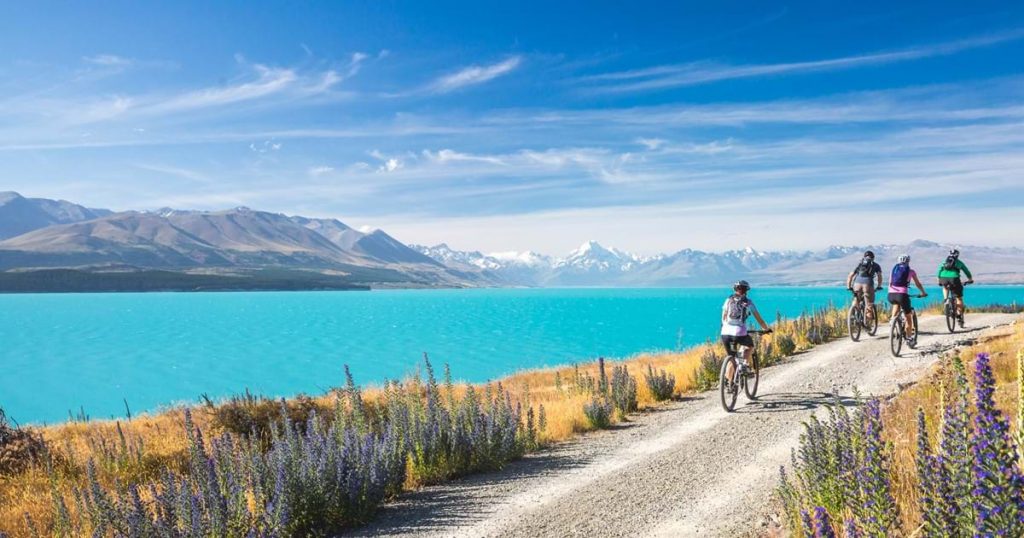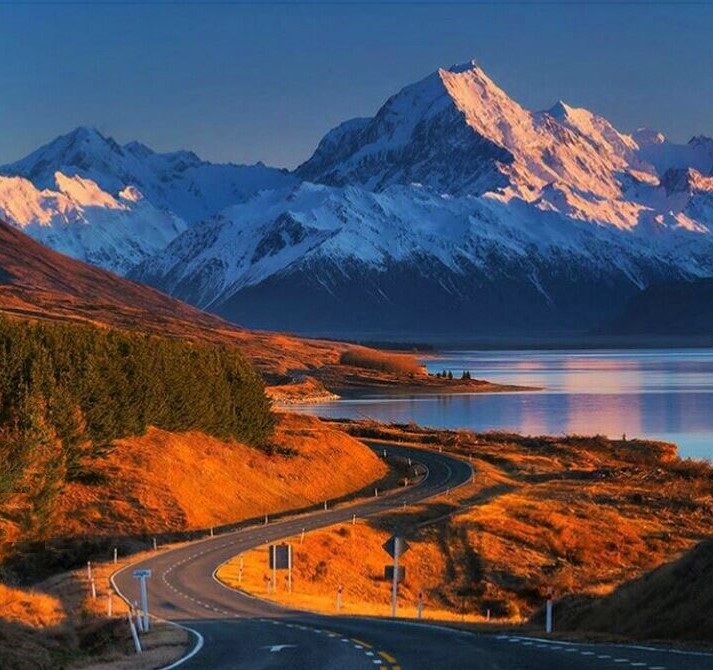The Mount Cook National Park is the home to New Zealand’s highest peaks; awe inspiring alpine landscape sprawled out 722 sq km punctuates a landscape of glacier-gouged valleys and accessible day walks providing thrilling glimpses of the country’s Mackenzie region.
From miraculously blue lakes and wide-open skies, to spiky mountain ranges piercing the clouds, exploring Mount Cook National Park offers an unmatched adventure that will leave you amazed.

How far to…
- Christchurch: 5 hours, 45 mins drive
- Lake Tekapo: 1 hour drive
- Twizel: 45 min drive
- Queenstown: 3 hour drive
The facts:
– Formally established in 1953
– 19 peaks over 3,000
– Area of 722 sq km
– Contains New Zealand’s longest glacier
Mt Cook National Park was established four months after Sir Edmund Hillary and Tenzing Norgay climbed Mt Everest, and the Kiwi conquerer of the world’s highest peak knew this rugged alpine region well. Sir Ed’s first significant summit was Mt Ollivier in the park’s Sealy Range in 1939, and in 1948 he was part of the first group to climb Aoraki/Mt Cook’s southern ridge.

The challenging mountaineering route is now named the Hillary Ridge, and in the quiet alpine village in the shadow of New Zealand’s highest peak, the country’s greatest son is also remembered for his adventures and achievements around the globe.
Most of New Zealand’s 19 highest peaks are gathered around Aoraki/Mt Cook, and a third of the park is perennially covered in snow and glacial ice. But despite offering Australasia’s most extreme alpine terrain, it’s easy for travellers to experience the park’s compelling spectacle and grandeur.
Giant glaciers cover 40% of the land, including New Zealand’s largest glacier – the Tasman Glacier and the four other major valley systems of the Godley, Murchison, Hooker and Mueller. Getting up close to one of these ancient natural phenomena by one of the many glacier experiences has to be seen to be believed.

Accessible day walks radiate out for views of blue-ice glaciers framed by a cobalt southern sky, and local operators offer tours in kayak and inflatable Zodiacs to explore dynamic and ever-changing glacial lakes. More intrepid adventures include negotiating the alpine landscapes on skis or snowshoes, or riding deep into the park on a 4WD vehicle.
For ultimate views of the park’s soaring alpine expanses – part of the World Heritage-listed Te Wāhipounamu-South West New Zealand Area covering a tenth of the country – helicopters and ski-planes negotiate careful routes between snow-covered peaks to land high on glaciers and snowfields.
When to go:
Spring and summer from October to April are the best times to explore the park’s excellent walking tracks and tramping trails, and from December to March, blooming mountain wildflowers include the Mt Cook lily, and alpine daisies, gentians and edelweiss.
Note the park’s weather can change quickly throughout the year. When setting out on longer tramps, hire an emergency locator beacon and complete an intentions card at the DOC (Department of Conservation) visitor centre.
What to do:
Walkers and hikers are spoilt for choice in the Mount Cook National Park, with trails ranging from easy short walks to challenging alpine expeditions. Stop to breathe in the fresh mountain air, look up at the unending sky, and marvel at the surrounding ranges.
Day walks leaving from the park’s alpine village include the Sealy Tarns Track (three to four hours return). More than 2000 steps come with the reward of spectacular views of alpine lakes. Three swing bridges punctuate the popular Hooker Valley Track (three hours return) leading to the terminus of the Hooker Glacier, while the Tasman Glacier View Track (30 minutes return) offers accessible views of Tasman Lake and the terminal face of Tasman Glacier.
Look forward to a good workout climbing the steps to the lookout. Views of blue-grey icebergs floating on the lake make it all worthwhile.
To engage with this fluid and ever-evolving landscape more closely, climb aboard an inflatable Zodiac with Glacier Explorers, or join a guided kayaking experience with Glacier Kayaking.
It’s also possible to explore the upper reaches of the glacier on skiing or snowshoeing adventures – access is provided by spectacular flights in helicopters or ski-planes – and exciting offroad tours in rugged 4WD vehicles provide rollicking access for superb glacier views. See mtcook.com for details.
Both Alpine Recreation and Alpine Guides can also arrange in-depth explorations of the park, including guided one-day tramps, heli-hiking on the Tasman Glacier, and adventurous multi- day hikes.
Experiencing the park is not limited to adventurous and active travellers. Throughout spring and summer especially, the park’s airstrip is enlivened with departures from aircraft offering scenic flights above and around New Zealand’s most spectacular alpine scenery.
Helicopter experiences with Heliworks Mt Cook include the 55-minute Aoraki/Mt Cook Ultimate flight circumnavigating the country’s highest peak – incorporating views of the West Coast’s Fox and Franz Josef glaciers, while Mt Cook Ski Planes & Helicopters offer good-value 30-minute flights up the Tasman Valley and Hochstetter Icefall to land on the Tasman Glacier.
Back on the ground, the Sir Edmund Hillary Alpine Centre at the historic Hermitage Hotel is a multi-media tribute to the pioneering mountaineer, explorer, and philanthropist. Sir Ed was very experienced in exploring the park’s challenging peaks, and memorabilia from his global adventures and a compelling 75-minute documentary about his conquest of Mt Everest are testament to a life exceptionally well-lived.

Screening in the centre’s digital planetarium is a presentation on New Zealand’s southern night sky, ideal preparation for visitors to then venture outside and survey the real thing through telescopes, binoculars and with an astronomy guide from Big Sky Stargazing.
Established in 2012, the Aoraki Mackenzie International Dark Sky Reserve comprises Mount Cook National Park and the nearby Mackenzie Basin.
In the heart of the South Island the sky is so clear and vast that millions of stars seem to appear right before your eyes.
Unique to the Mackenzie Region, the clear skies found in this part of the world are like nothing else in New Zealand. Very limited light pollution means the views of the night sky seem to stretch on as far as the eye can see.
In 2012, the 4300 square kilometre area was declared the Aoraki Mackenzie International Dark Sky Reserve, with light pollution strictly controlled in the area. It is the only one of its kind in the Southern Hemisphere, and one of only eight in the world. Within this reserve is New Zealand’s premier astronomical research centre, the Mount John Observatory.
Seeing this sky through a telescope is an experience unlike any other. Take the time to look up, study the galaxies and stars, and feel connected to the awesome history of the universe. There are a number of ways to take a stargazing tour in the Mackenzie Region.
Keen stargazers will see amazing constellations that can only be seen in the southern hemisphere, including the Southern Cross, to the Magellanic Clouds and the Milky Way.
Accommodation:
Accommodation in Aoraki/Mount Cook alpine village ranges from one of New Zealand’s best YHA hostels to the luxury and heritage of the Hermitage. A good choice for families are the ensuite rooms at the Aoraki Alpine Lodge or the studios and two-bedroom units at the Aoraki Court motel.
Tent sites and parking for campervans and caravans is available at DOC’s White Horse Hill Campground in the scenic Hooker Valley, while campsites, backpacker dorms and motel units can be found at the Glentanner Park Centre 22km south of the village on Lake Pukaki. See doc.govt.nz for details of park accommodation including alpine huts and more basic bivouac shelters.
Nestled in the park is Aoraki/Mount Cook Village, which has accommodation options for travellers exploring the park. Glentanner is a 15-minute drive away and also offers accommodation options. The rugged and ever-changing landscape surrounding these towns is spectacular all year round.
Booking ahead for the popular Mueller Hut is mandatory from November to April.
Location:
At the western edge of Canterbury’s spectacular Mackenzie Country and abutting Westland Tai Poutini National Park, Mount Cook National Park is easily reached from Christchurch.
Look forward to a drive of around four hours via Geraldine, Fairlie and Lake Tekapo. The final part of the journey runs along the turquoise-coloured Lake Pukaki.

From Dunedin, travel north along SH1, and then venture west from Oamaru through the Waitaki Valley to Twizel. This journey is also around four hours.
This route is also the basis of the Alps 2 Ocean Cycle Trail travelling more than 300km from Mount Cook National Park to Oamaru.
Gateway town:
Near the southern end of Lake Pukaki, Twizel is 67km (45 minutes) from Aoraki/Mount Cook alpine village. Accommodation includes Omahau Downs, with cosy self-contained cottages on a sheep farm, while there’s a choice of two Four Square supermarkets for supplies before heading off on tramps in the park.
For coffee and breakfast, head to Poppies Cafe or Shawtys, while the best after-dark action combines local craft beer from Burkes Brewing and wood-fired pizza at the Ministry of Works Bar & Eatery.
See Southern Alps Outdoors for camping gas, fishing licenses and any last-minute tramping and outdoor needs.
Source : Stuff
For more information: Visit doc.govt.nz and mackenzienz.com.

[…] A guide to Aoraki/Mt Cook National Park […]